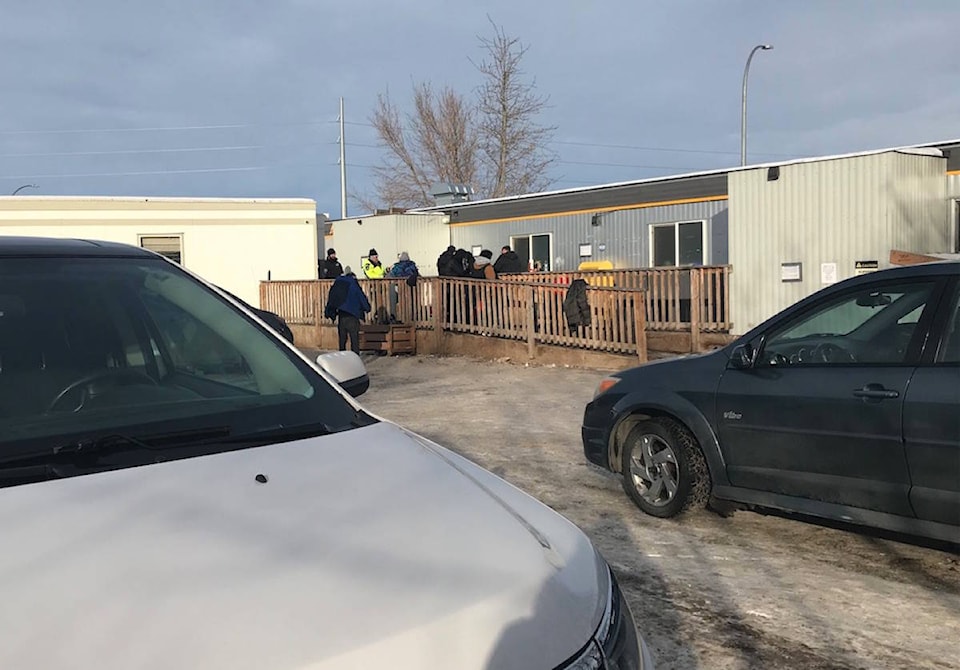A 40-year-old opioid user credits staff at the overdose prevention site in Red Deer for their ongoing support.
With their encouragement, he’s planning to enter detox in a couple of days.
“This can be a stressful and trying place to work,” said Dennis of the busy overdose prevention site, located in an ATCO trailer at the Safe Harbour facility behind Superstore.
The four spots provided for drug users were filled on Friday morning and an informal lineup had formed outside.
“But everyone is so kind and passionate about what they are doing — and that’s a big thing,” said the Red Deer resident, who didn’t want his full name used because of public judgment.
The former oilfield worker, granite cutter and chef has heard about the hurtful online comments from people who don’t think addicts are worth saving.
“I think a little love can go a long way in all of this,” he responds.
“People would be better off if they could return a bit of humanity to the world, some compassion and empathy…”
ALSO READ: David Marsden: Drug addicts deserve our care
At the same time, Dennis understands, and even sympathizes with, the many people who have been victimized by crime and who feel that homeless addicts are ruining the city.
“I don’t believe in taking what people have worked hard for,” he says, preferring to trade services for drugs. (He helps people inject and they help him out with product.)
He knows theft is up with drug use and the poor economy, and that some shoppers have been scared out of the downtown. But Dennis cautions that both addictions and the situation in the city’s core are complex issues that can’t be solved with easy answers that come out of uninformed opinions.
He encourages people to “take the time to do the research.”
If they did, he’s convinced that community members would understand that the overdose prevention site is making a positive difference in the community.
There’s far less needle debris in the streets since the facility opened, because used needles do not leave the premises, says Dennis.
It has also saved lives: Dennis recalls having to administer naloxone to reverse about 150 overdoses of friends in the community before the facility opened. Since then, he’s only had to respond to five to 10 of these emergencies.
He hopes the provincial government allows the site to transition into a supervised consumption site with wrap-around services — to keep people alive until they are ready to deal with their drug issues.
“Some (users) are not ready to face up to the hurt and problems that they will have to deal with to become clean,” says Dennis.
While he’s had periods of sobriety, he’s always fallen back on drugs at times of difficulty or stress.
Over the years, he has held down various jobs. But his drug dependency grew during the last economic downturn, when he was laid off from the oilfield. Dennis said he couldn’t pay for his rental apartment and ended up on the street.
Being homeless is a major hurdle to getting clean, he adds, since it means living among other people who are dealing with addiction issues at shelters, or in parks.
Although Dennis has a long history of drug use — he started smoking marijuana at age 13, then moved into harder substances to deal with emotional trauma — he hopes his next detox will direct him toward a better life.
For now, he and other users are bringing their own drugs to the overdose prevention site so that staff can observe them as they inject to ensure that they don’t overdose — and that the needles they are using don’t leave the facility.
Dennis knows the sight of addicts bothers shoppers and business owners. He believes the loitering would be minimized if Red Deer had a supervised consumption site at which more drug users — including those who smoke or sniff drugs — could be observed indoors at one time.
But the downtown’s problems can’t solely be pinned on homeless people, he says, adding that commercial developments in Timberlands, Clearview Ridge and the southend have also given people less reason to go to the the city’s core.
Looking ahead, Dennis envisions himself being drug free and working at a place such as Safe Harbour, or Turning Point, which runs the overdose prevention site.
“I’d like to give back and I’d use the job as a tool to help me retain my sobriety.”
lmichelin@reddeeradvocate.com
Like us on Facebook and follow us on Twitter
